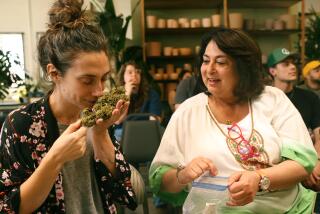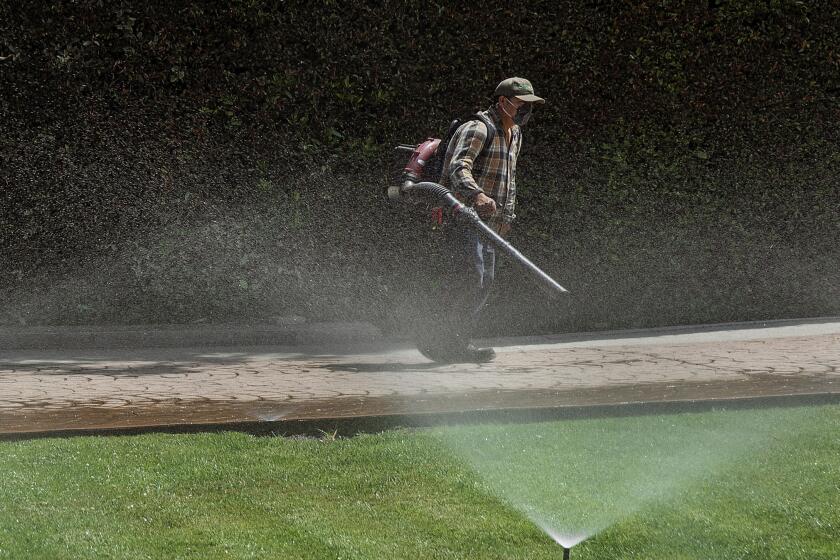Garden Full of Cat Food : Edible Plants Can Delight Feline Friends
- Share via
If Whiskers is nibbling on your zinnias or rolling around in the dirt next to your tomato plant, it may be time for a garden of his own.
Providing your feline friend with an edible garden has a variety of benefits. A garden offers your cat a special place where he can enjoy fresh air and sunshine while nibbling on a variety of vitamin and mineral-rich plants.
“Providing a secure outdoor garden is a valuable part of good cat care,” says Dori Slater, a veterinarian who has an enclosed garden for her four indoor cats, Leah, Lucky, Tuxedo and Lacy. “Cats love to sleep among the plants, play and watch the world go by. A garden relieves boredom, especially if the owner is away at work all day.”
An outdoor garden for cats also has a variety of health benefits.
“Natural sunlight on the fur stimulates vitamin D production for healthy bones. Sunlight through glass doesn’t provide these benefits,” says Slater. “And daily exposure to periods of light and dark influences normal neuroendocrine functions.”
The plants cats like to snack on are also often high in vitamins and minerals. Parsley is a favorite that provides vitamins A, B, C and beta carotene, potassium and other minerals, while carrot tops contain Vitamin A and beta carotene, and spinach is high in calcium and Vitamins C and A.
A cat garden can also make a colorful display. Felines enjoy attractive edible flowers such as zinnias, marigolds and Johnny-jump-ups, as well as catnip, cat thyme, oat grass, rosemary and bean sprouts.
Although catnip has a reputation as a cat favorite, you might want to try some on your cat before you plant it, because not all cats like it. It’s important to try fresh catnip; dried taste differently.
“Some cats take to catnip and some don’t,” says Mary Lou Heard of Heard’s Country Gardens in Westminster. She says cat thyme is very similar.
One plant that just about all cats like is oat grass, she says. “When cats are hungry for chlorophyll, they eat grass.”
Adds Slater, “The good thing about oat grass is that it doesn’t have serrated edges or rough foliage, so cats are less likely to vomit after ingesting it.”
For your cat’s safety and economy’s sake, it’s often a good idea to raise plants from seed. That way you know that the plants haven’t been treated with any harmful chemicals, and you’re not spending a great deal of money on plants that often need to be replaced regularly.
“You can start just about all of the plants that cats like from seed,” says Heard, who suggests planting seeds in containers.
She makes a mixture of one-third potting soil, one-third peat moss and one-third vermiculite and then sprinkles seeds on top. So that the seeds don’t wash away, water from the bottom or spray the top with a fine mist. If the container is outside, cover the seeds with a thin layer of peat moss so that birds don’t eat them.
“Place the container in an area that gets partial light and watch it closely, because you don’t want the seeds to dry out even for an hour--they will die,” says Heard.
If you are worried about your seeds not getting enough moisture or would like them to germinate more quickly, Heard suggests making a small “humidity chamber.”
“Put the container in a plastic bag, blow it up and seal it shut,” she says. “When the seedlings come up, remove the bag immediately or the plants could get a deadly fungus.”
This shortcut is especially helpful for slow germinating seeds such as parsley, which can take two to five weeks to germinate, and carrots which don’t pop up for one to three weeks.
Nola Skyler of Huntington Beach, a member of the Orange County Horticultural Society, speeds the germination time of carrots by soaking them first. “They have a tough thick hull and this seems to soften them up,” she says.
Oat grass comes up in just a couple of days, and catnip and spinach only take about a week. Rosemary and cat thyme are usually started from root cuttings of other plants, so you want to obtain them as whole plants.
It’s a good idea to continually reseed the plants cats like to eat. Slater suggests planting new oat grass every two to three weeks so your cat will have a constant supply of tender sprouts.
For catnip, Heard suggests having two containers of the plant. One can rejuvenate while the other is being eaten and played with by the cats.
“Catnip will come back to life,” says Heard. “Just cut out the bad parts and give it some time; it will grow full again.”
When choosing plants for your cat garden, remember that some plants are poisonous. Oleander, for instance, is deadly. “Just one leaf can kill a cat and even a person,” says Slater, who suggests not having any oleander in your landscape if you have a cat.
“Oleander is very oily. Your cat could lie near the plant and then lick his fur,” she says.
Other poisonous plants to avoid include poinsettias, yew, lily of the valley, philodendron, azalea, bulbs, sweat pea, jimson weed, dieffenbachia, large leaf ivy, mistletoe, cherry, morning glory, iris, mushrooms and rhubarb leaves.
“Also don’t plant anything that produces foxtails; these can cause serious medical problems if swallowed or caught in the ear canal, paw pads or tail base,” says Slater.
When fertilizing your plants, you must also be very careful.
“If the cats are going to eat the plants, don’t use chemical fertilizers,” says Heard. “Use non-chemical fertilizers such as blood meal, fish emulsion, bone meal and kelp.”
Never use a systemic fertilizer; it can work its way into the plants.
When it comes to pest control, it’s best to stay away from all chemicals. Heard suggests sticking to hand-washing with water and insecticidal soap or cutting back infected plant parts.
Both of these methods generally work against the chief pest for these crops: aphids.
“Pesticides can be extremely dangerous in the garden, especially Snarol pellets, which resemble cat food,” says Slater. “Every spring when people start gardening, pet emergency rooms get about five poisoning cases each weekend.”
You don’t need a large yard to have a cat garden. Use some imagination when choosing a site. Slater put her cat garden in a side walkway. It uses one wall of the house, which is where the cat door is located.
“There’s a lot you can do,” says Slater. “If you live in an apartment, you can cover up your balcony and put in a bunch of plants in containers. I’ve even talked to people who have created runways from their houses to certain areas of their yard. If nothing else, you could create a miniature cat garden in a window box where the cats could go to nibble on plants and get air from an open window.”
Place the garden where it gets sun and shade and is sheltered from direct wind.
Whenever possible, Slater suggests enclosing the garden. A good way to do this is with PVC plumbing pipe and wire. Make certain the structure is sturdy and that there are no holes or gaps any larger than two inches because your cat could get its leg or head caught.
To upgrade the garden, add fruit tree branches for climbing and scratching, scratching posts, a cat condo and wicker containers for sleeping, suspended mobiles or a night light, which will attract bugs and moths.






